"As Catholics in the Archdiocese of St. Louis, in communion with the Bishop of Rome, we are called by our Lord Jesus Christ to be His Church and live His Gospel. With joy, we strive to fulfill our Baptismal calling by prayer and worship, teaching and sharing our faith, serving others, and fostering unity in diversity. Guided by the Holy Spirit, we commit ourselves to the responsible stewardship of all God's gifts" (Archbishop Justin Rigali, Mission Statement, Strategic Pastoral Plan for the Archdiocese of St. Louis, 1997).
A New Shepherd
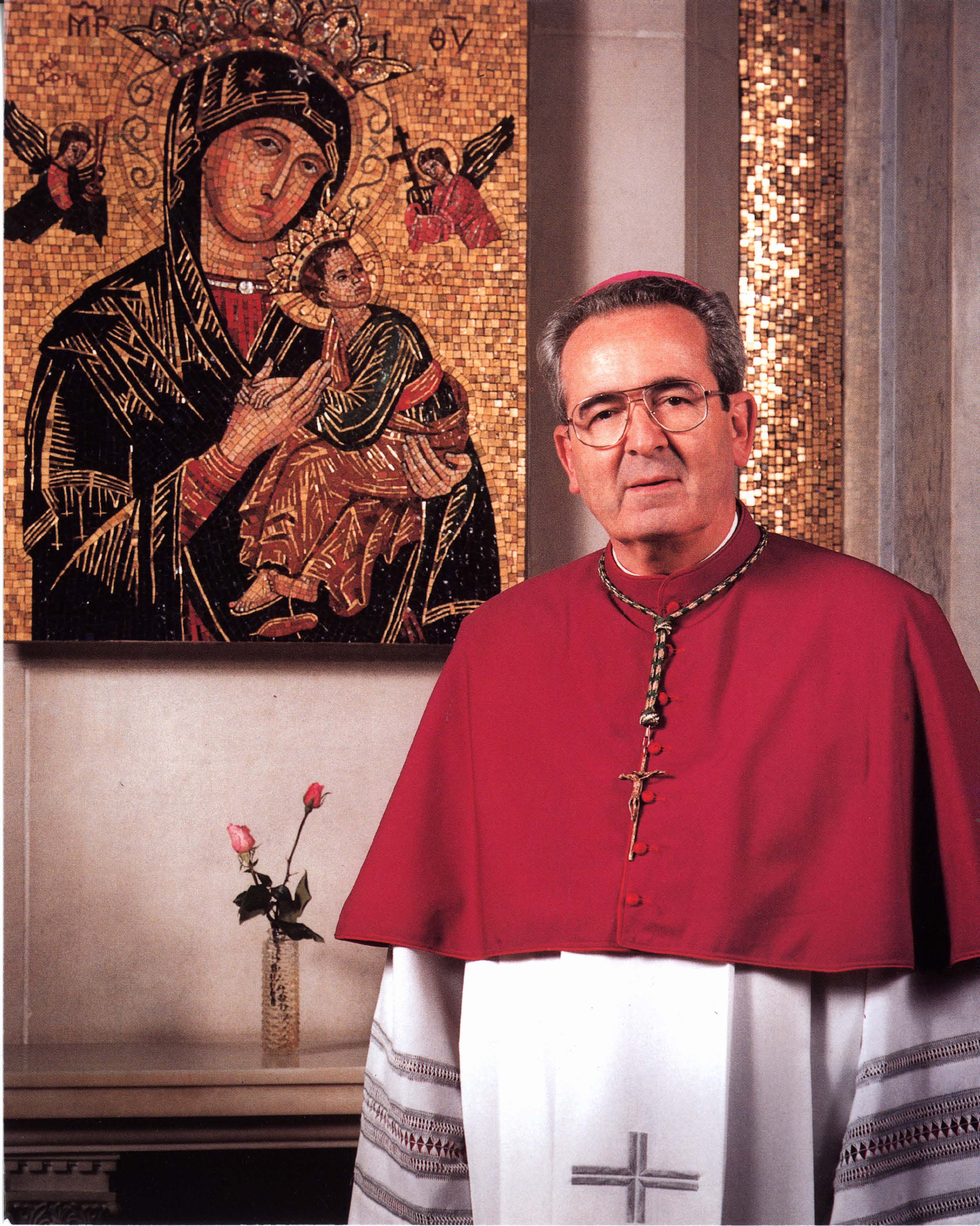
On January 25th, 1994, on the feast of the Conversion of St. Paul, His Holiness Pope John Paul II gave to the Archdiocese of St. Louis one of his own trusted aides as its new archbishop. Justin Francis Rigali, a priest of Los Angeles who had worked in Rome for several popes, an archbishop who had himself been involved with the work of selecting bishops, was chosen to lead the faithful of St. Louis into the new Christian era signaled by the Great Jubilee that would occur in the year 2000. Rigali was installed as the eighth Bishop and seventh Archbishop of St. Louis on March 16, 1994.
Archbishop Rigali, by means of his own faithful presentations of the Catholic faith, and his close personal affiliation with the great Pontiff, would bring to his pastoral duties a keen understanding of the Universal Church. The archbishop would gather around himself a loyal and competent staff, particularly in the person of his Vicars General: Bishops Edward Braxton, Joseph Naumann and Michael Sheridan, and Monsignor Richard Stika. He would ordain these three bishops as auxiliaries for St. Louis. Two former staff members, John Gaydos and George Lucas, would be named ordinaries of the surrounding dioceses of Jefferson City and Springfield in Illinois. His active auxiliaries upon arrival, Bishops Edward O'Donnell and Paul Zipfel, assisted in the transition of leadership, and soon would be named to the Dioceses of Lafayette (Louisiana) and Bismarck (South Dakota). Several years later Bishop Braxton was appointed to the Diocese of Lake Charles (Louisiana) and then later to the Diocese of Belleville (Illinois).
Within his first 500 days, Archbishop Rigali had begun a collaborative effort to map out the priorities that would focus the attention and energies of clergy, religious, and laity for the next several years. Widely surveying the "state of the Church," and encouraging the archdiocese's half-million Catholics to express their hopes, concerns, and aspirations for the future, from the mass of data came the groundwork for the strategic pastoral plan for the archdiocese.
Among other changes, in 1995 Archbishop Rigali announced that after 177 years of collaboration with the Vincentian community in running Kenrick-Glennon Seminary, the archdiocese would henceforth assume full responsibility the archdiocese assumed the administration of Kenrick-Glennon Seminary.
In 1997, the St. Louis Cathedral was designated a basilica on the 150th anniversary of the archdiocese. The colloquially-known "New Cathedral" and mother-church of the archdiocese, became the Cathedral Basilica of Saint Louis.
A Clear Vision, a Collaborative Plan
That same year, Archbishop Rigali began implementation of the first strategic pastoral plan for the archdiocese. The aim, Archbishop Rigali said, is to be not only a more efficient Church, but also a holier, more vital Church. The goals were to: foster conversion through prayer and the sacraments; proclaim Jesus Christ in word and in action; renew the commitment to the Catholic education; serve those in need; and be responsible stewards. Archbishop Rigali exercised a calm but fervent spiritual leadership in his role as archbishop. The vision he gave in the first promulgation of his Pastoral Plan set forth five goals that would guide the journey of the Church in St. Louis. They were: 1) To Foster Conversion Through Prayer and the Sacraments; 2) To Proclaim Jesus Christ in Word and in Action; 3) To Renew Our Commitment to Catholic Education in All Its Forms; 4) To Serve Those in Need; 5) To Be Responsible Stewards of God's Gifts to Us. Their implementation would "give flesh" in a broad-based way to issues that he had already begun to highlight in his weekly column, his homilies, and in the course of his pastoral activities.
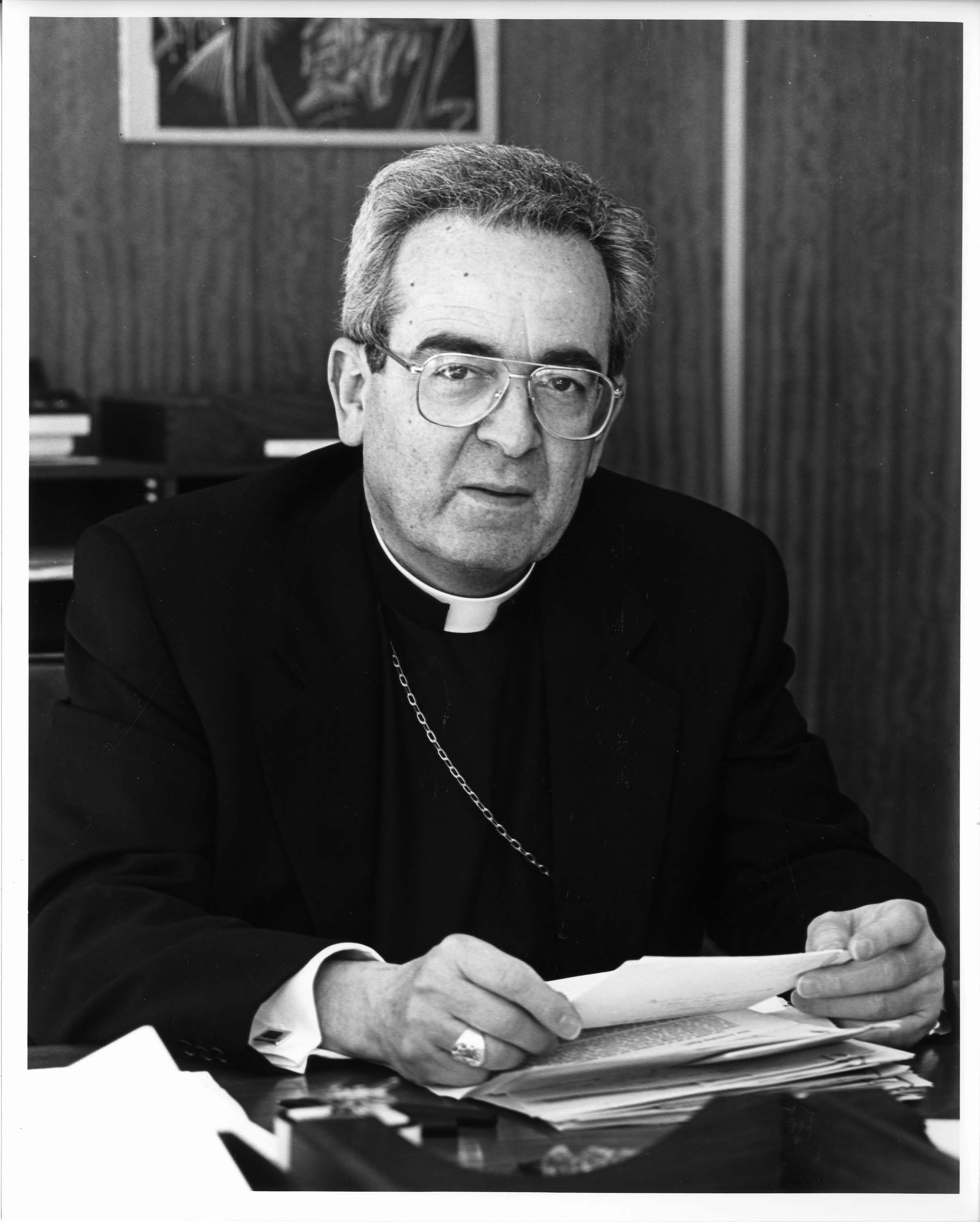
An early theme expressed in one of Archbishop Rigali's first Advent messages illustrated the centrality of the Eucharist in the life of the Church and at the same time indicated something of the Blessed Sacrament's importance in his own spiritual life. He had already been inviting small groups of priests to lunch at his residence, beginning their visit with a full hour of quiet prayer before the Real Presence in his chapel. The archbishop was also intent on encouraging worship of the Holy Eucharist outside of Mass, particularly for the intention of priestly and religious vocations. Throughout the archdiocese Rigali encouraged periods of exposition and benediction, and sound catechesis on the connection between Eucharistic devotion and the Sacrifice of the Mass. By the year 2000, 23 parishes in the archdiocese had Perpetual Eucharistic Adoration--24 hours a day, seven days a week.
The archbishop's goal of conversion included a strong emphasis on the Sacrament of Penance, and in 1999, Reconciliation Weekend engaged 300 priests in service to nearly 40,000 faithful, at 62 sites throughout the archdiocese. In commenting on the weekend Rigali said that this extraordinary moment of reconciliation would help "to heighten the appreciation of still greater numbers of our people for the immense value of regular and frequent celebration of the Sacrament of Penance."
Papal Visit and jubilee year
1999 was an immensely significant year for the Archdiocese of St. Louis, as it would host a visit from a pope who would be named a saint. His Holiness Pope John Paul II made a pastoral visit to St. Louis. The Pastoral Visit of His Holiness Pope John Paul II, January 26-27, 1999, was an event unmatched in the memory of St. Louisans. Months of intense organization and preparation receded the event; the local media gave the story saturation coverage; and the city all but shut down on the days themselves.
The Universal Church was preparing for the Great Jubilee Year in 2000 through a series of continental synods 'for the sake of the new evangelization,' and Archbishop Rigali was selected as a member of the 1997 Synod for America. In the course of the meetings with bishops and observers from North, South, and Central America, and the Caribbean, Rigali's interventions treated the universal call to holiness and the centrality of the Eucharist.
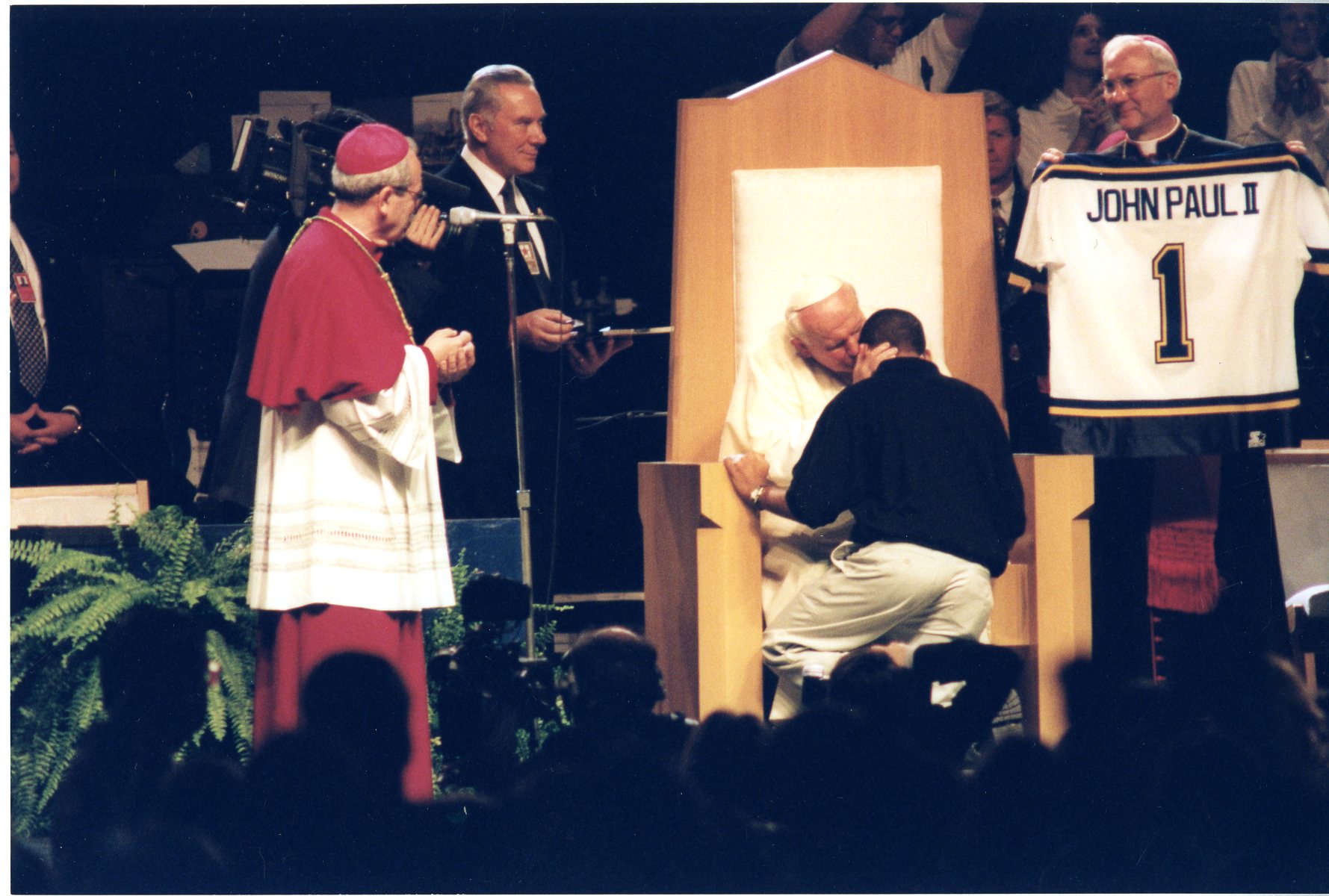
When the time came for the promulgation of the post-synodal exhortation, it was customary for the Pope to travel to the respective area of the world to formally announce the findings of the Synod Fathers. On January 22, 1999, the Holy Father went to Mexico City and the shrine of the patroness of America, Our Lady of Guadalupe, to give the world the document on "The Church in America." But at the invitation of his long-time collaborator, he could complete his passage to America with a Pastoral Visit to St. Louis. The 32-hour visit to the archdiocese was arguably the singular most significant historical event in the life of the local Church since its founding in 1826. On January 26 and 27, 1999, St. Louis was the heart of the Church. In the person of Pope John Paul II, 'Peter', the Vicar of Christ was in our midst.
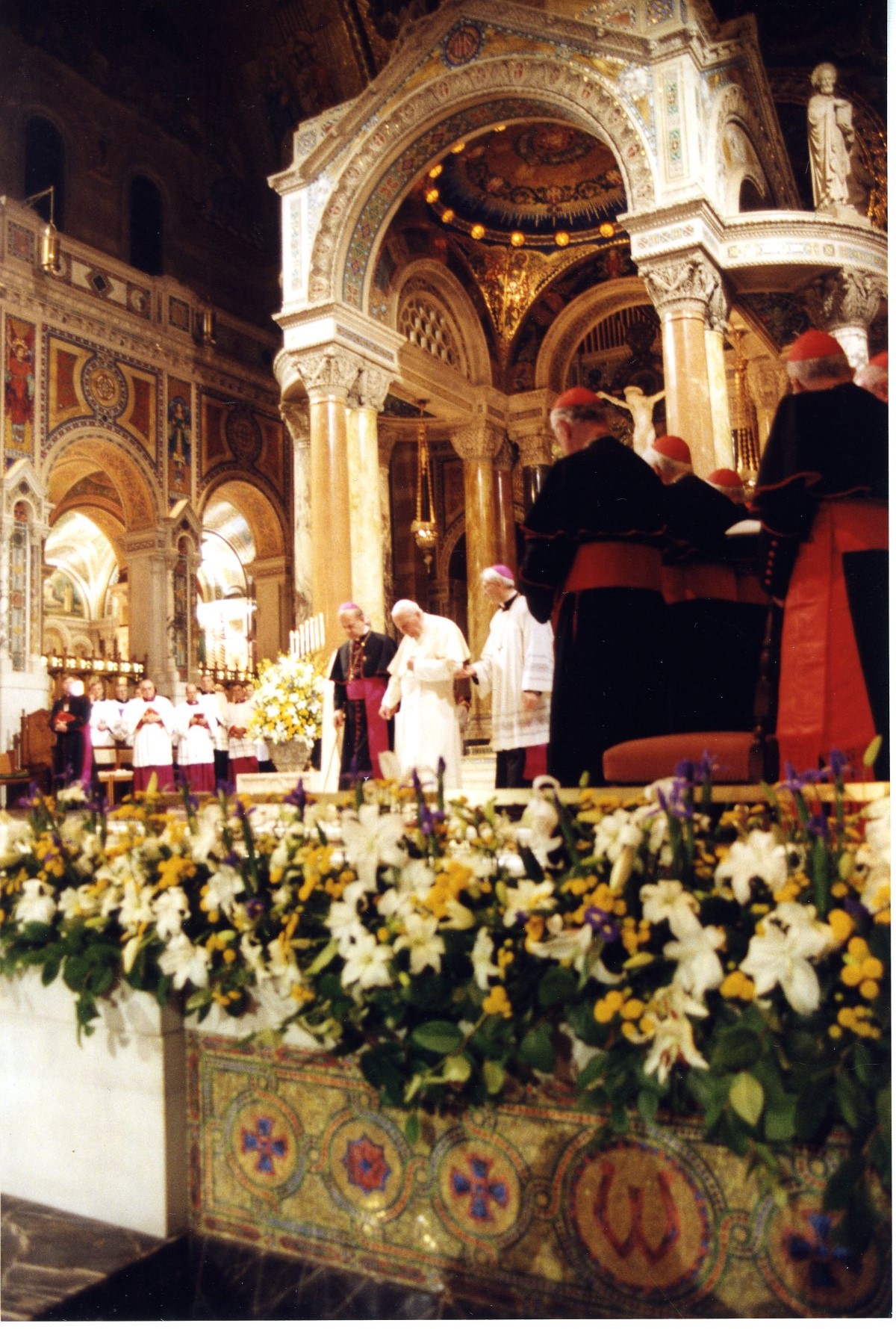
2000 was the Jubilee Year. Archbishop Rigali designated 15 pilgrimage churches throughout the archdiocese as sites for Holy Year celebrations. This Holy Year of 2000 was not simply an anniversary of Christian nostalgia, but a challenge to repentance, renewal, and reconciliation. Thousands of Catholics in the archdiocese attended the 17 Pilgrimage Masses during the year and a special Jubilee indulgence was received by those who participated in such Masses.
As a centennial of the first formal National Eucharistic Congress in the United States held in St. Louis in 1901, the archdiocese made plans to convene an Archdiocesan Eucharistic Congress on Corpus Christi Weekend, 2001. Cardinal Jan Schotte, the Vatican Secretary General of the Synod of Bishops would address the gathering. The event would culminate with Mass at the TransWorld Dome, followed by a procession to the St. Louis Riverfront and Benediction.
On July 15, 2003, Cardinal Rigali was appointed the 12th bishop/eighth Archbishop of Philadelphia; his Installation took place on October 7, 2003, and on September 28, 2003, he was appointed to the College of Cardinals by His Holiness Pope John Paul II.
Archbishop Raymond L. Burke
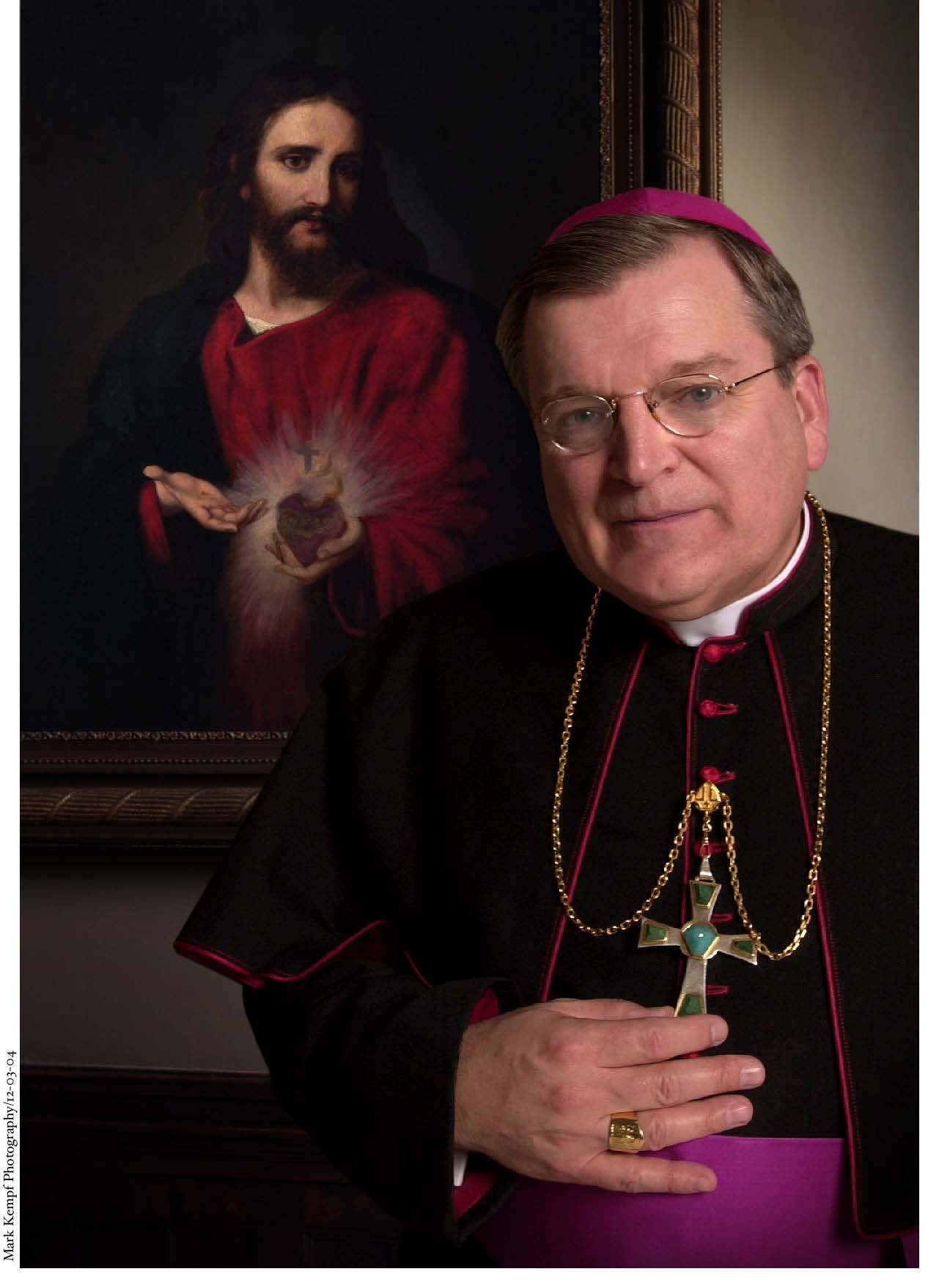
Raymond Leo Burke, one of the world's foremost authorities on Roman Catholic canon law, was named Archbishop of St. Louis on December 2, 2003 and was installed as the ninth Bishop and eighth Archbishop of St. Louis on January 26, 2004, succeeding then-Cardinal Justin Francis Rigali. Burke was installed by the Reverend Monsignor Leopoldo Girelli, consigliere of the Apostolic Nunciature in the United States, on January 26, 2004. Archbishop Burke was presented with the pallium on June 29, 2004 by Pope John Paul II.
As Archbishop of St. Louis, Burke guided the Archdiocese of St. Louis in the teachings of the Catholic faith. He lead with an unwavering passion for the integrity of Catholic doctrine embodied in the words of Jesus Christ.
Born on June 30, 1948 in Richland Center, Wisconsin, Archbishop Burke's path to the priesthood took him to Rome, where he was ordained by Pope Paul VI on June 29, 1975. One of his first assignments was teaching religion at Aquinas High School in LaCrosse, Wisconsin. He was ordained a bishop at St. Peter's Basilica, Vatican City, on January 6, 1995. He was installed as the 8th bishop of LaCrosse Wisconsin before becoming the Archbishop of St. Louis in 2004. His call to serve God has been expressed through a scholarly devotion to faith. He studied canon law at the Pontifical Gregorian University in Rome and later became the first American to hold the position of Defender of the Bond of the Supreme Tribunal of the Apostolic Signatura, the church's highest court.
A Strong Supporter of Vocations
During his time in St. Louis, Burke emphasized the promotion of vocations to the priesthood. The vocation to the priesthood was exceedingly important to Archbishop Burke and he soon became known for his informal walks through the city's Central West End and Forest Park with the seminarians who were studying at Kenrick-Glennon Seminary. In an interview in the St. Louis Review, after it had been announced that Burke would be leaving St. Louis for a new position in Rome, the Archbishop remarked, "I’ll miss Forest Park very much. I enjoyed the walks I took there with the seminarians."
Archbishop Burke’s great love for and devotion to the Church and its people could be seen in his tireless efforts to foster vocations to the priesthood and religious
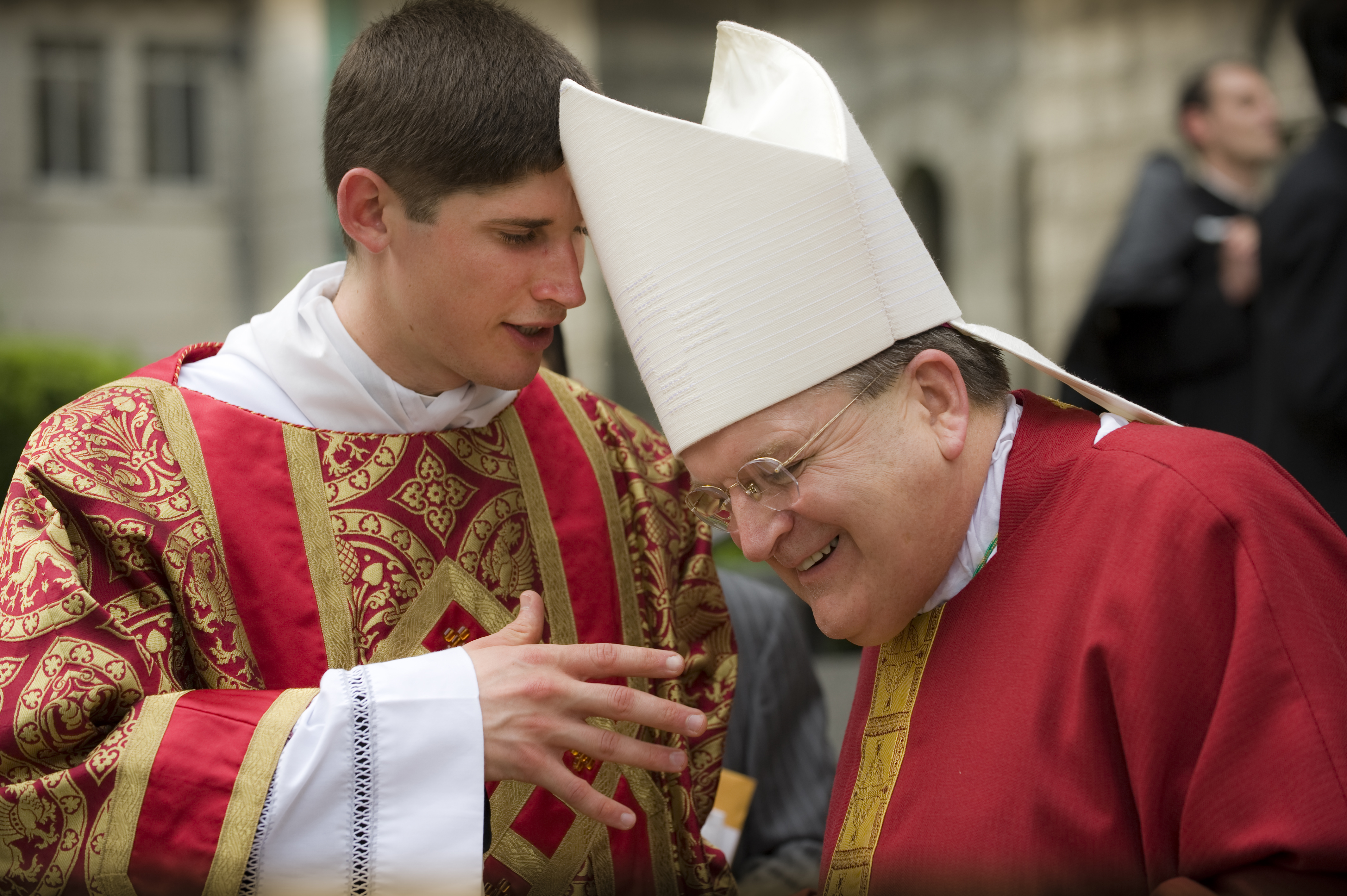
life. "Vocations and the priesthood are at the very heart of the archdiocese," he had said many times while archbishop of St. Louis. And they were at the center of his own heart, too. Archbishop Burke was often credited with helping to make the seminary program at Kenrick-Glennon one of the finest in the country, academically, spiritually, and pastorally. Among his efforts, Burke helped to create a summer program for seminarians focusing on Hispanic ministry. He began sending seminarians to Creighton University during the summer for additional training on how to grow in their own spirituality. He also saw to it that more seminarians were placed in parishes to gain hands-on experience.
In January of 2008, Burke announced the start of a major renovation of Kenrick-Glennon Seminary. Again, in his parting interview with the St. Louis Review, he stated, "One thing is the work at the seminary, in terms of the infrastructure and new addition. That’s a major project, and it’s just beginning, which I had hoped to complete."
Schism and The Court of Public Opinion
During his tenure, Burke was involved in the beginning of a contest over the attempted closing of a church in the diocese, St. Stanislaus Kostka Church, and the ownership of its assets. After the Rev. Marek Bozek led a Christmas Eve Mass in 2005, Burke "declare[d] that the church was in 'schism', a designation that led to the excommunication of Mr. Bozek and the church's lay board". In 2012, a state court ruled against the diocese and sided with the congregation, now an independent Catholic church, and awarded it ownership of the parish assets.
In his 2008 parting interview, Archbishop Burke addressed the situation as a, "...painful experience during my time here .... But [it does] not define St. Louis for me. I consider [it] to be [an] anomalous situation[s] with which as archbishop I needed to deal. I tried to deal with [it] in the best way possible. People can question individual prudential judgments that I made, but as I said, I don’t have any regret about confronting the issues that needed to be addressed."
Respect for Life and Stem-cell Research
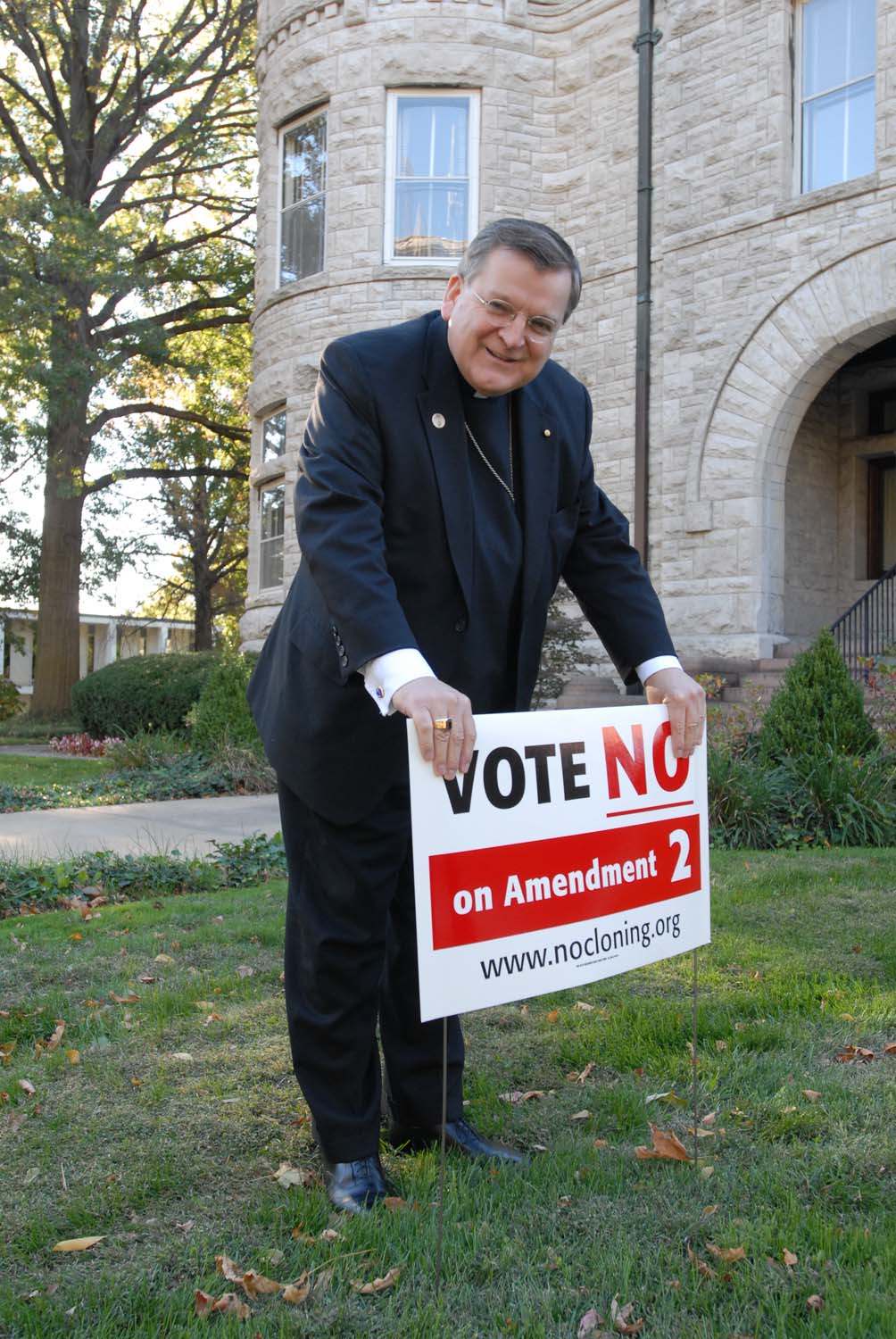
In 2006, when Missouri voters narrowly approved Amendment 2, an amendment to the state constitution permitting embryonic stem cell research, Archbishop Burke, already a strong voice in the pro-life movement, took a visible stand against using embryonic stem-cells for research. Of the initiative, Burke said it meant that "our tiniest brothers and sisters ... will be made legally the subjects, the slaves, of those who wish to manipulate and destroy their lives for the sake of supposed scientific and technological progress." In a St. Louis Review interview the Archbishop stated that, "although we made major inroads during the campaign against Amendment 2, we ultimately did not succeed in keeping this anti-life amendment out of the state constitution. Although we made an effort to try to repeal it, so far it’s not succeeded."
Summorum Pontificum and st. louis
In response to the 2007 apostolic letter "Summorum Pontificum," by Pope Benedict XVI, Archbishop Burke made use of the opportunity to remind and further instruct the faithful in the Archdiocese of St. Louis that, "...with the norms promulgated by Pope Benedict XVI, the Novus Ordo remains the ordinary form in which the Rite of the Mass is to be celebrated. The Order of the Mass in force before the changes introduced by the Novus Ordo is now the extraordinary form, which may be celebrated by any priest, without special permission, under the conditions set forth by the Holy Father. In establishing the extraordinary form of the Rite of the Mass, our Holy Father reminds us that, in fact, the use of the Roman Missal of Blessed Pope John XXIII "was never juridically abrogated and, consequently, in principle, was always permitted" (Letter of Pope Benedict XVI Accompanying the Apostolic Letter Summorum Pontificum, July 7, 2007, paragraph 6)."
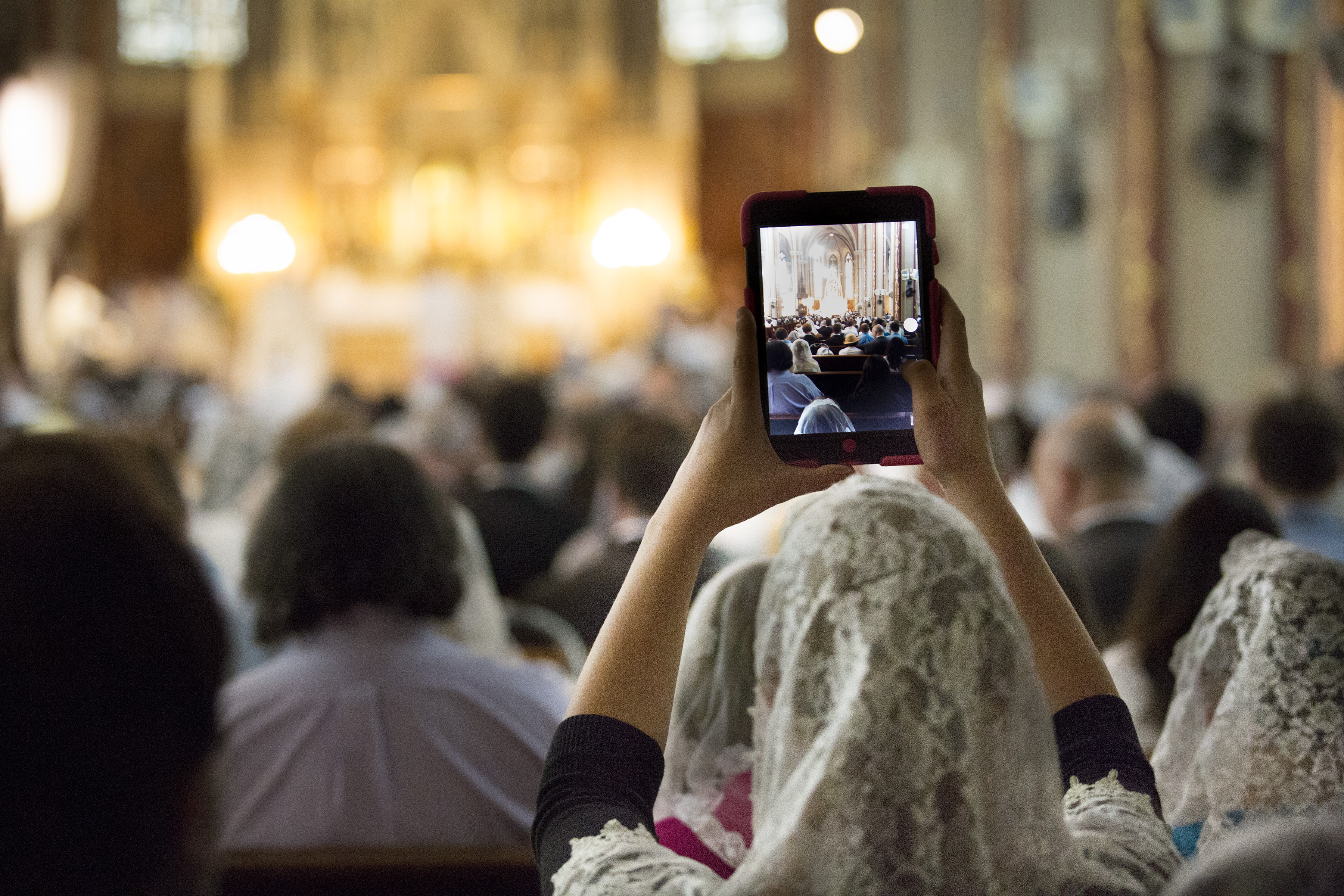
Struck by young people who were attracted to the former order of the Mass, even though they had no experience of it when they were growing up, and noting that the Archdiocese of St. Louis had a most effective apostolate on behalf of the faithful who were attached to the extraordinary form of the Rite of the Mass, that is the Roman Missal of Blessed Pope John XXIII, Burke established oratories for those desiring to worship according to the Traditional Latin Mass. He invited the traditional Institute of Christ the King Sovereign Priest (ICKSP) into the archdiocese and ordained priests for the group both in the U.S. and abroad. His ordination of two ICKSP priests on June 15, 2007 in the Solemn Pontifical High Mass was the first time in 40 years that the traditional rite of ordination had been used in the Cathedral Basilica of Saint Louis.
Prefect of the Apostolic Signatura
Burke had previously been appointed a member of several dicasteries of the Roman Curia, including on May 6, 2008, of the Pontifical Council for Legislative Texts, which authoritatively interprets canon law, and of the Congregation for the Clergy, which regulates the formation and training of diocesan priests and deacons. On October 7, 2008, Burke was appointed President of the Commission for Advocates, which is responsible for admitting qualified canon lawyers to a registry of those who may practice in the Vatican's courts.
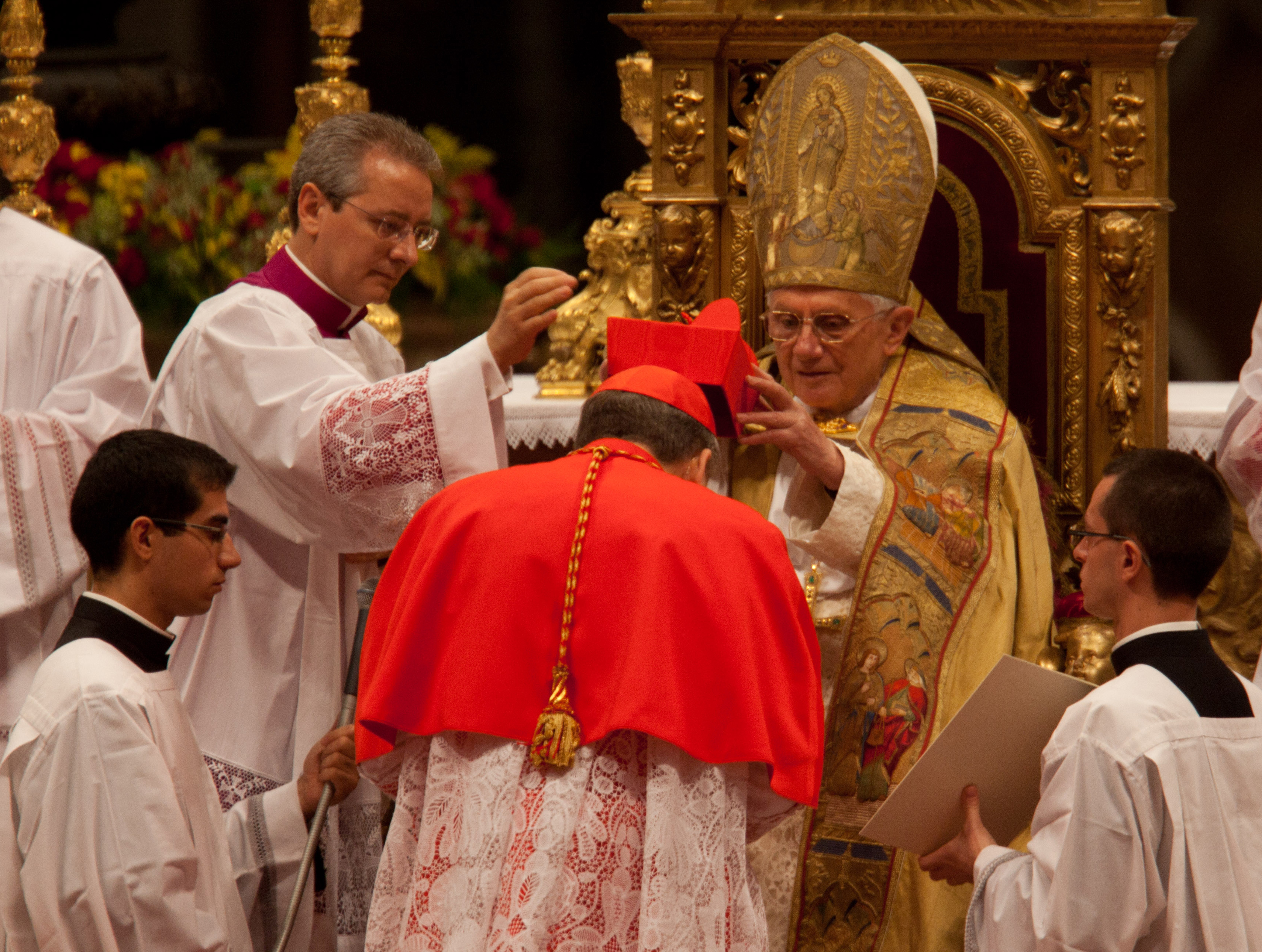
On June 27, 2008, Pope Benedict XVI appointed Burke Prefect of the Supreme Tribunal of the Apostolic Signatura, which exercises final appellate jurisdiction for conflicts between Vatican congregations and appeals of administrative decisions by diocesan bishops and Vatican congregations. Burke was the first non-European named to head the tribunal and became the second-highest ranking American prelate at the Vatican after Cardinal William Levada, the prefect of the Congregation for the Doctrine of the Faith. He would leave the Archdiocese of St. Louis for Rome, and would be elevated to the Sacred College of Cardinals.
On November 20, 2010, Pope Benedict XVI made Burke Cardinal-Deacon of Sant'Agata dei Goti, the fifth Archbishop of St. Louis to become a member of the College of Cardinals. On February 5, 2011, the memorial of St. Agatha, Burke took canonical possession of his titular church in Rome. When asked in his final interview with the St. Louis Review what his initial and parting impressions were of St. Louis, the Archbishop stated, "My first impression was of a very strong Catholic community that was very welcoming and also very responsive to the teaching of the Church and to the leadership of the Archbishop. I’ve always said about St. Louis, is that it’s a very large metropolitan area, but there’s a very homey aspect to it. It seems that most people know each other. there’s a kind of closeness and pride. That was something I have always enjoyed about St. Louis."
Burke's farewell Mass in the Archdiocese of St. Louis, was held in the Cathedral Basilica of Saint Louis on August 17, 2008, and was concelebrated by bishops George Joseph Lucas, Robert Joseph Hermann, John Joseph Leibrecht, John R. Gaydos, Robert W. Finn, Raymond James Boland, and Kevin William Vann.
His Holiness Pope Benedict XVI named Archbishop Burke Archbishop Emeritus of the Archdiocese of St. Louis, providing a link in perpetuity between the Archdiocese and the Cardinal.
Archbishop Robert J. Carlson
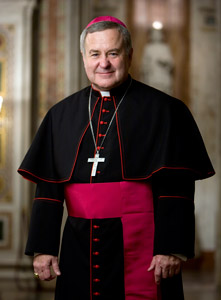
The Most Reverend Robert J. Carlson, a native of Minneapolis, Minnesota, was ordained to the priesthood in 1970 for the Archdiocese of St. Paul and Minneapolis. He went on to receive a master’s degree in divinity from St. Paul Seminary in 1976 and a licentiate in canon law from the Catholic University of America in 1979. Ordained as an auxiliary bishop for his home archdiocese in 1984, he went on to serve as Bishop of Sioux Falls, South Dakota, (1994-2005) and the Bishop of Saginaw, Michigan (2005-2009).
Archbishop Robert J. Carlson was installed as Archbishop of St. Louis at the Cathedral Basilica of Saint Louis on June 10, 2009. He received the pallium from Pope Benedict XVI on June 29, 2009, in a ceremony at St. Peter's Basilica.
From an initial interview with the St. Louis Review Carlson stated that when he was informed of the Holy Father’s decision to appoint him as Archbishop of St. Louis, his response was, “I will start to pray today that I love everybody.” Slightly tearing up, he added: “I look forward to being the spiritual leader of this community. “You have to love the people you serve,” he noted. “And if you want to see Christ in somebody, you have to love them, and you have to have a feeling for them.” He went on to add, “I’m especially pleased with the outreach to the poor, which seems to be a real strength this archdiocese." “You also have a very strong and vibrant Catholic school system, which excites me, since I went to Catholic schools from kindergarten through 11 years of college.”
Archbishop Carlson noted that the two primary responsibilities of a bishop are to “care for his priests — and in turn, they care for the people; and secondly to raise up new vocations to the priesthood and religious life.”
Faith For The Future
In January of 2008, Archbishop Raymond Burke had announced the start of a major renovation of Kenrick-Glennon Seminary. In 2009, after Burke had been called to Rome and Archbishop Carlson had been installed in St. Louis, the Faith for the Future Capital Campaign was conducted in the Archdiocese of St. Louis for the purpose of financing the renovation of the Kenrick-Glennon Seminary building. The entire seminary community moved to a temporary residence for a year and a half during the renovation.
The Kenrick-Glennon facility dates to 1931, and over the decades very few improvements had been made to the original structure.The physical and financial needs supported though Faith for the Future included updates to:
- Infrastructure, providing a suitable living and educational environment for seminarians.
- Faculty offices
- Seminarian rooms
- The Fr. Emil Kapaun Student Center
- Learning Resource Center
- An endowment to help defray the cost of undergraduate and graduate level education and living expenses for seminarians
- The Chapel of St. Joseph. Renovations to the chapel included the construction of a new altar of sacrifice, installation of a new pipe organ, the construction of a wooden ciborium (baldacchino) in the apse, the painting of the chapel ceiling, and the refurbishment of the wood in the chapel (pews, floors, etc). The new altar of sacrifice was consecrated by Archbishop Carlson in May 2015. For further details on the chapel renovations, click here.
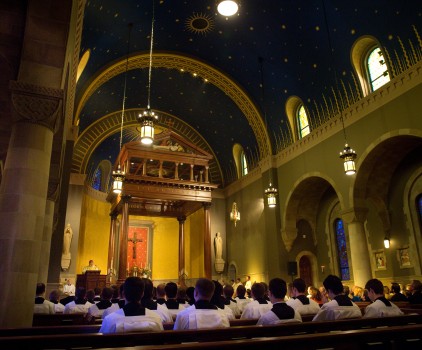
The renovations and building projects required the seminary to relocate for a year and a half, from the start of the 2011-12 school year through Christmas 2012. The seminarians lived in the Franciscan Sisters of Mary convent behind St. Mary's Hospital, with classes at the former CBC high school across Clayton Road. Kenrick-Glennon students moved back to Shrewsbury for the second semester of the 2012-13 school year.
The Faith for the Future campaign was a smashing success, eclipsing the goal of $50 million with $62.5 million in pledges. The total collected was $57 million, with $43.5 million of that going toward new construction or infrastructure upgrades. Another $9 million went into the Kenrick-Glennon endowment; future contributions will go there as well. The remainder went to administrative expenses and fees.
The project won an award from the American Institute of Architects.
Mission Advancement Initiative
Since his arrival in St. Louis, the archbishop stressed that Catholic education was his first priority. Alive in Christ, his mission advancement initiative, was begun in 2010 to strengthen and grow Catholic education in the Archdiocese of St. Louis and grow Catholic schools to be Alive in Christ.
From the beginning, Carlson insisted that Catholic schools must be vibrant and growing, in their Catholic identity, their enrollment and their financial viability, while being strong instruments of evangelization, catechesis and social justice.
After gaining input from more than 3,000 people across the 11-county archdiocese and concentrated effort from members of four mission advancement planning teams, the archbishop made his decision to achieve his goals by 2018, the 200th anniversary of Catholic education in the St. Louis Archdiocese. Alive in Christ was to involve all schools. Although the parish assessment only included elementary schools, a capital campaign and new archdiocesan foundation would seek additional funding for tuition assistance for high school students.
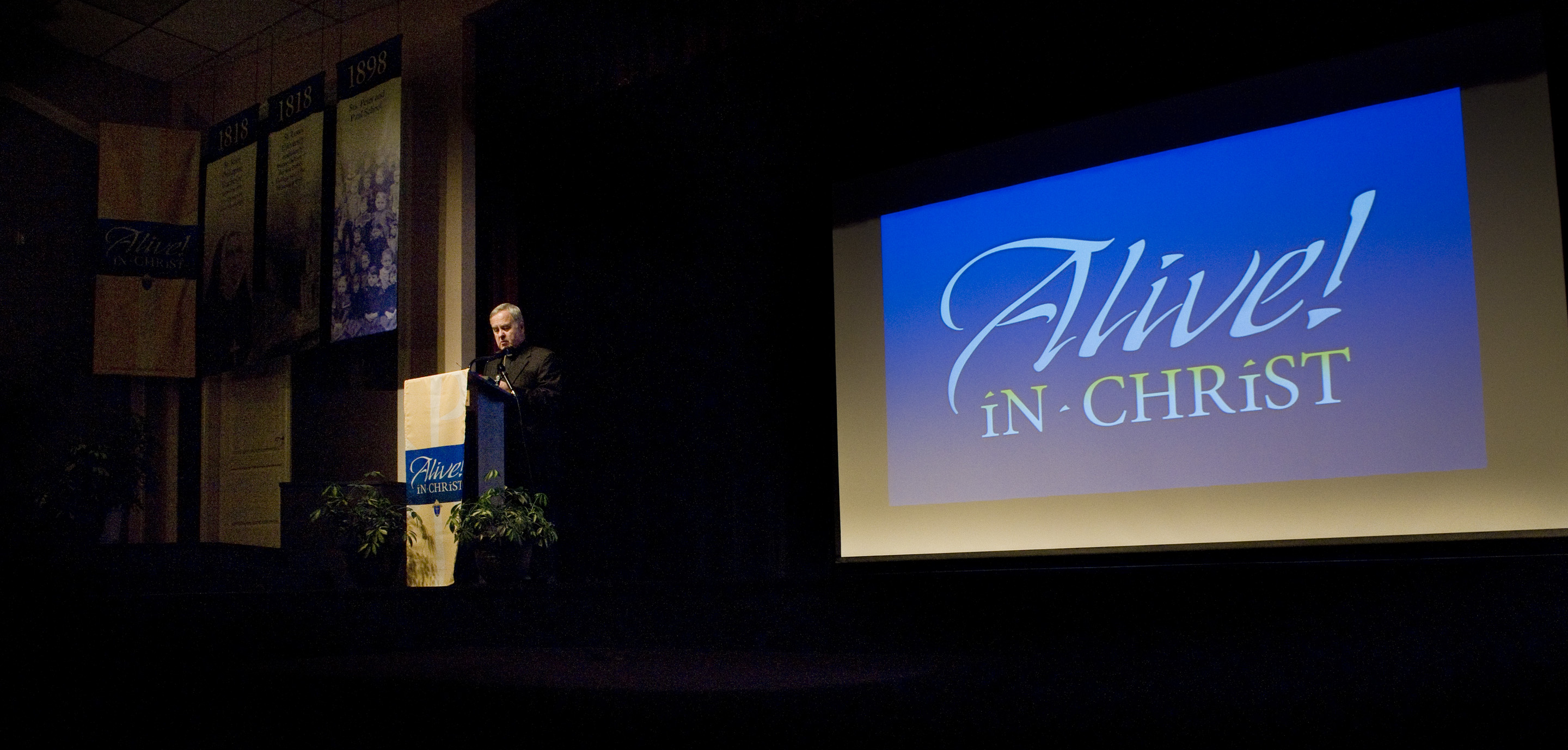
At a February 2, 2010 unveiling of the M.A.I., the archbishop explained, "Alive In Christ was designed to help each parish and school build its capacity for advancing the Church's mission. This is important to every Catholic in the archdiocese because in part, we've come to think of Catholic schools in terms of dollars and cents. The truth is that Catholic schools today are the best tool of evangelization we have. And it is the responsibility of every baptized Catholic to carry out the mission of evangelization."
The priorities of this initiative were:
1. All Catholic schools must strengthen their Catholic identity in a variety of ways, including regularly scheduled prayer and Mass, apologetics classes for eighth-graders and requiring that every teacher read the Catechism of the Catholic Church. New opportunities will be provided for adult faith formation, including classes on the sacraments for parents of students in Catholic schools. Outreach programs will be created for parents after their child is baptized, to welcome and connect them to the parish community, with resources for education and faith formation of preschool children, and opportunity to reserve space for them in the parish school. Parishes, schools and agencies will continue outreach efforts to inactive Catholics, including parents of students in Catholic schools, to help them return home to the Church. Catholic schools will be authentically Catholic, providing children and their families with a sound faith foundation and knowledge of Catholic beliefs.
2. All schools must develop and establish benchmarks and standards of excellence for academics, as well as faith formation. Academics have been and will continue to be a great strength of the Catholic school system in our archdiocese. Our students score more than 20 percentile points above the national average on the Iowa Test of Basic Skills. Our Catholic high schools have a 99-plus percent graduation rate and 98 percent of those graduates attend college.
3. Developing standards of excellence for academics and faith formation will certainly include our students with disabilities and special needs. We will support and expand all efforts to meet the special education and faith formation needs of our children with special needs.
4. Commitment to helping the poor and marginalized reach their full potential through education. This includes children who are not Catholic. We are also committed to providing a place in our Catholic schools for every child whose parents want that child to receive a Catholic education in every one of the 11 counties of our archdiocese, in urban, suburban and rural parishes. Carlson has said, there should be no empty seats in our Catholic schools.
5. The mission advancement initiative is addressing the financial aspect of Catholic education — which is really an issue of stewardship — in several ways.
First, every elementary school must create a marketing and enrollment plan to manage and increase their enrollment numbers. Full enrollment helps keep tuition affordable.
Second, there will be proactive, deanery-based planning to encourage collaborative strategy and development among parishes and schools. One example of such effort is the creation of Holy Cross Academy, the new elementary school system created from three neighboring schools — Annunciation in Webster Groves, St. Michael the Archangel in Shrewsbury and Our Lady of Providence in Crestwood. The three schools are forming into one school on three campuses to strengthen Catholic education for area families without duplication of efforts. This type of collaborative and innovative thinking can help continue Catholic education, especially in areas of changing demographics.
Third, the archdiocese will be working closely with the Missouri Catholic Conference to seek government assistance where appropriate and achievable. Currently there are two bills in the Missouri General Assembly, SJR 47 and HJR 70, seeking to amend the Missouri Constitution to remove anti-Catholic provisions that prohibit assistance common in many other states.
Fourth, the Archdiocese of St. Louis will create new funding mechanisms to help make Catholic schools financially sound and affordable.
6. a) A parish assessment of 2% of all parish external revenue (excluding endowment contributions). This will begin with a 1% assessment on July 1, the beginning of the fiscal year, and go to the full 2% on July 1, 2013. This will remain a permanent annual contribution for each parish. This money will be used to assist families to provide Catholic education for their children. Some 80% of the funds will provide tuition assistance to eligible families in parish-based elementary schools. Funds will be awarded based on the needs of the families involved, not the needs of the parishes to which they belong. The remaining 20% of these funds were assist families in identified mission schools, with fewer resources and more needs, to help at-risk students. All mission school families were expected to pay a portion of the tuition to be eligible for this funding.
b) An archdiocesan-wide capital campaign was to be developed, and to begin in 2014, to generate an additional $5 million in endowment revenue, to assist families with elementary school age children. This was in addition to already existing endowment funds in the archdiocese.
c) An archdiocesan Catholic foundation was to be established to develop and manage endowment funds for all archdiocesan ministries, with special emphasis on tuition assistance needs for Catholic families.
The Fight for Religious Liberty
On January 20, 2012, the U.S. Department of Health and Human Services (HHS) issued a mandate under the Affordable Care Act (also known as “Obamacare”) that required all employer health plans to provide free contraceptives, sterilizations and abortion-inducing drugs, regardless of any moral or religious objections.
The Catholic Church immediately began to argue that Her institutions would be forced to provide services that directly contradict the teachings of the Faith, and—more alarmingly— the federal government claimed the right to decide for religious institutions what constituted their "ministry."
Archbishop Carlson was an early voice in the fight for Religious Liberty. On February 15, 2012, he issued the following Pastoral Letter:
The Catholic bishops have long supported access to life-affirming health care for all, and the conscience rights of everyone involved in the complex process of providing that health care. That is why we object to the "preventive services" regulation issued by the Obama administration last August.
First, we object to the rule forcing private health plans to cover sterilization and contraception, including drugs that may cause abortion. All the other mandated "services" prevent disease. Pregnancy is not a disease. Moreover, forcing plans to cover abortifacients violates existing federal conscience laws. Therefore, we call for the rescission of the mandate altogether.
Second, we object to the fact that the mandate imposes a burden of unprecedented reach and severity on the consciences of those who consider such "services" immoral. We therefore urge the Obama administration, if it insists on keeping the mandate, to provide a conscience exemption for all who object to these practices -- not just the extremely small subset of "religious employers" that HHS proposed to exempt initially.
The Catholic Church joins with other faiths and with non-religious people throughout the United States in vigorously opposing the Obama administration's attempt to impose its values on others. If the government has the right to force people to violate their religious or ethical beliefs in this way, then we are no longer living in the United States of America. We have been kidnapped and transported against our wills to a land that is governed by dictators who care nothing for the values enshrined in the First Amendment. It is one thing for our government to permit moral evils like abortion, sterilization and artificial contraception. It is quite another thing to requireorganizations that find these practices morally offensive to provide these "services" to their employees and to require individuals who conscientiously object to these practices to pay for them (directly or indirectly).
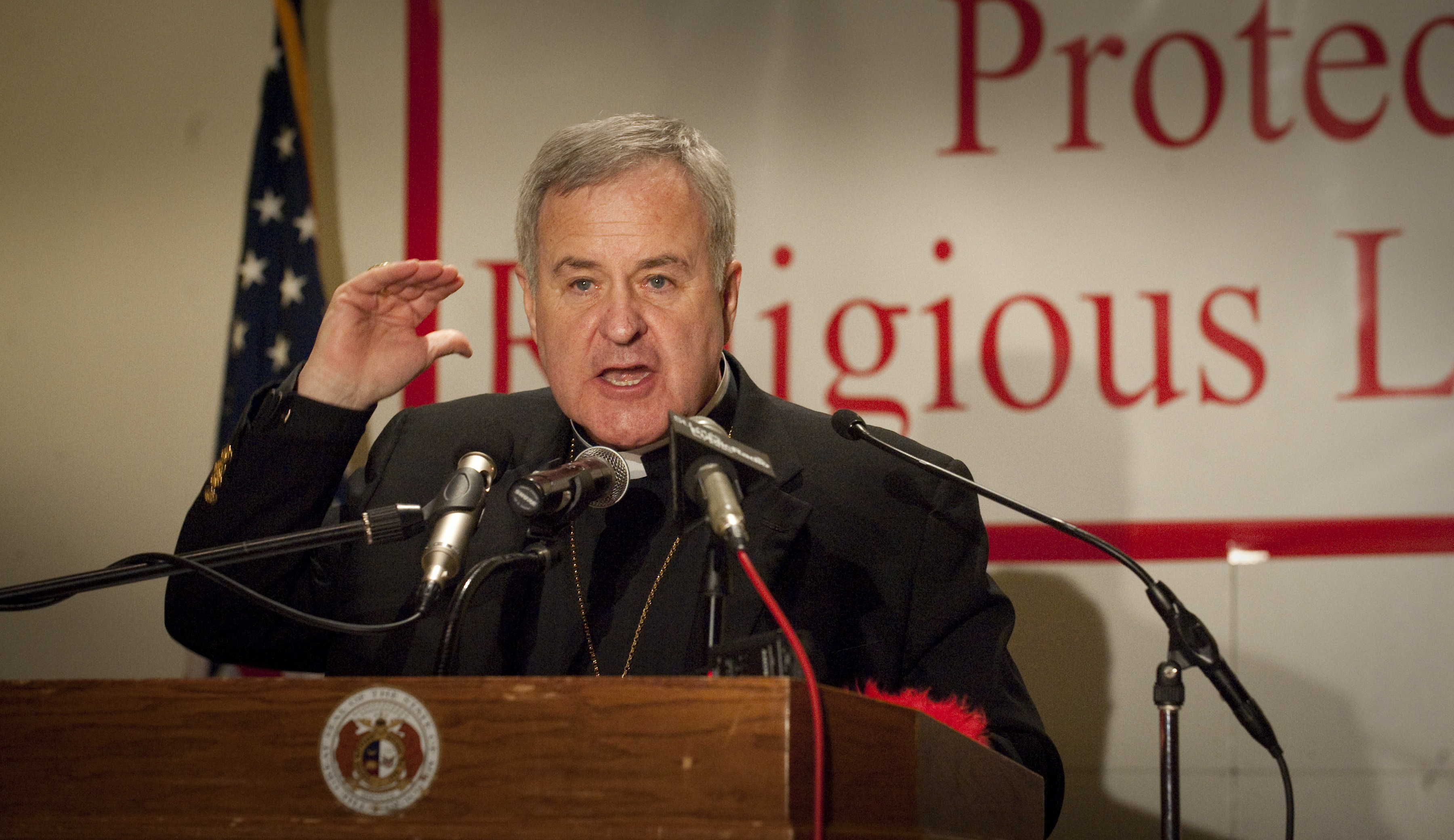 President Obama has now done two things.
President Obama has now done two things.
First, he has decided to retain HHS's nationwide mandate of insurance coverage of sterilization and contraception, including some abortifacients. This is both unsupported in the law and remains a grave moral concern. We cannot fail to reiterate this point: Those who object to such practices should not be required by their government to provide or pay for them -- whether directly or indirectly.
Second, the president has announced some changes in how the HHS mandate will be administered. These changes, which are still unclear in their details, require careful moral analysis, but we note at the outset that the lack of clear protection for key stakeholders (including self-insured religious employers, religious and secular for-profit employers, secular non-profit employers, religious insurers and individuals) is unacceptable and must be corrected. And in the case where the employee and insurer agree to add the objectionable coverage even when it is not described in the organization's list of benefits, that coverage is still provided as a part of the objecting employer's plan, financed in the same way as the rest of the coverage offered by the objecting employer. This is simply a smokescreen designed to obscure the fact that the morally offensive practices are being provided as an integral part of the plan.
Those of us who object to the HHS mandate on fundamental moral principles will continue to press for the greatest conscience protection we can secure from the executive branch of our federal government. But in the final analysis, our opposition to the HHS mandate is not primarily about Church teaching on sterilization, abortion-inducing drugs or artificial contraception -- no matter how much the news media and the Obama administration try to spin it that way in an effort to suggest that the Church is simply out of touch with its people.
Our deeply seated objection to this act of moral dictatorship is, first and foremost, about government intrusion in the internal governance of religious institutions. It's about our government's effort to coerce religious people (and other people of conscience) to violate their most deeply held convictions. In a nation dedicated to religious liberty as its first and founding principle, American citizens should not be required to negotiate with government bureaucrats within these unacceptable, and ultimately unconstitutional, parameters. The only complete solution to this religious liberty problem is for HHS to rescind the mandate of these objectionable services.
We will therefore continue with no less vigor, and no less sense of urgency, our efforts to correct this problem through the other two branches of government. For example, we renew our call on Congress to pass, and the administration to sign, the Respect for Rights of Conscience Act. We renew our call to the Catholic faithful, and all Americans, to join together to protect religious liberty and freedom of conscience for all.
As Catholics, and as Americans, it is our deeply held belief that the First Amendment, and the fundamental principles of our American way of life, guarantee that we have an inalienable right to follow our consciences and to express our religious and moral beliefs without government interference.
Most Rev. Robert J. Carlson
Archbishop of St. Louis
On March 27, 2012, Archbishop Carlson joined fellow Missouri Bishops and thousands of Missourians at the State Capitol in Jefferson City for the Rally for Religious Liberty.
Addressing thousands of Missourians in the rotunda of the State Capitol, Archbishop Carlson sent a message to the United States Government in no uncertain terms, closing his address with the following: My brothers and sisters, will you stand with me and say, “Jesus, I will take up my cross and follow You wherever the path takes us” Mr. Obama, you should know that we are ready to suffer for our convictions. You can fine us, and we won’t pay. You can put me in jail, I don’t care. But we will remain committed to the end of what our Lord has taught us and what he has called us to do as his witnesses and disciples. We’ve been here before -- remember Rome Mr. Obama, remember Rome.
Video of the Archbishop's full address:
Ferguson, Peace, And Justice
Providing A Pastoral Presence In Ferguson
The highly-publicized Ferguson unrest involved protests and riots that began the day after the fatal shooting of Michael Brown by a white police officer on August 9, 2014, in Ferguson, Missouri.
After the police officer involved in the shooting was not indicted, violence and unrest erupted in the city of Ferguson. Archbishop Carlson decided to first visit police officers who would be on the front lines, to protect and to serve: In the afternoon at the City Police Command Post with Auxiliary Bishop Edward M. Rice, and in the evening at the Central Patrol Division on North Jefferson Avenue, where Missouri National Guardsmen were stationed. Finally, he would go to Blessed Teresa of Calcutta, which had scheduled a Rosary and prayer service to begin At 8 P.M. Just when St. Louis County Prosecutor Robert McCulloch was scheduled to announce the Grand Jury decision.
At both police venues, Archbishop Carlson walked among the officers, many wearing their protective equipment and ready for action. He shook hands, greeted officers and thanked them for their service. In turn, they thanked him for being there. Archbishop Carlson addressed officers at both venues, thanking them for their sacrifices and their families' sacrifices and offering prayers for their safety when the streets became mean. "We pray, Lord, that You wrap them in Your protection and that You stand with them in the long hours that they have to work, on behalf of all of us," he said. "We ask that this be a peaceful night, a night when every police officer is kept safe. ... We pray, Lord, with the gifts and talents You bless these people with, that they not only make our city safe but protect people and keep them from harm." He asked St. Michael the Archangel -- the Patron Saint of police officers -- to intercede on their behalf. "Lord, we know You love these men and women," Archbishop Carlson said. "We know you’re with them in everything, and they know they have our support as well. May they never forget how proud we are and how awesome it is what they do."
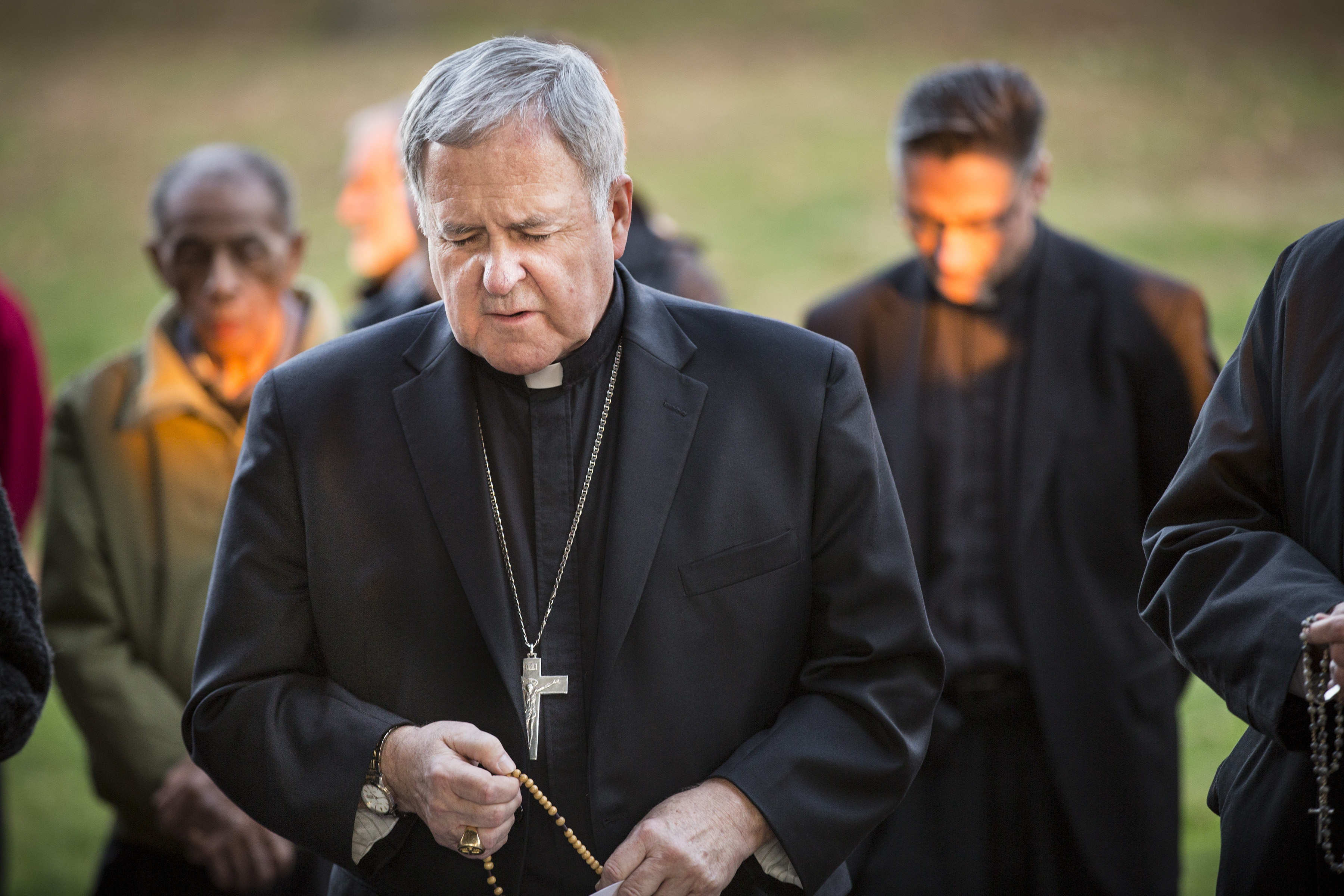
Throughout the unrest, including during a visit to Ferguson just days after the shooting, Archbishop Carlson maintained that peace should not be an unrealistic dream, but rather, our affirmation of peace in the world is a public commitment to justice. "Where there is no justice, there cannot be peace. Peace and justice are not in competition," Carlson stated at an interfaith prayer service.
The Archdiocesan Response
In August 2014, just weeks after the events in Ferguson, Archbishop Carlson announced he was re-establishing an Archdiocesan commission on human tights. In a memo announcing the Commission members, the Archbishop stated, “Peace and justice are the hallmarks of a society that knows, loves and serves God above all else. I urge this new commission to assist the citizens and public officials throughout all eleven counties of our Archdiocese in the effort to achieve peace and justice for all.”
Archbishop Carlson appointed 27 individuals to the Commission. Members of the Commission include lay persons, clergy, religious sisters, police officers, attorneys, and educators.
The Peace and Justice Commission develops its priorities by looking at how issues affecting our region specifically impact the family. As Catholics we believe as Pope Francis stated, "The family is the fundamental cell of society, where we learn to live with others despite our differences and belong to one another.” By working to help strengthen the family, the Commission hopes to help build stronger communities and a peaceful and just region and world.
beONE
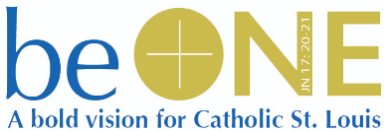
In 2015, Carlson unveiled beONE. beONE is a call to the revitalization of our local Church. It is a call to renew our baptismal promises to be the Church, to live out the Gospel and help one another be more Catholic and get to Heaven. Each parish was asked develop their own strategies and goals for achieving these objectives. Completing the Parish Viability Study was a first step in the process. Each parish was to use that report to identify several initial goals they would work on as a community to improve the health and vitality of the parish.
The vision for beONE was developed over a nine-month process of listening to feedback from people in parishes, Church leadership and others, with the ultimate goal of advancing Christ's mission. The four priorities have specific goals over the next several years, including opportunities for intercultural dialogue, forming stronger sister parish relationships, supporting Catholic education through the Beyond Sunday campaign, lay formation and a parish viability study.
beONE is not a program. beONE is a way to think about what we do (and don’t do). “BeONE is a vision for the future of Catholics in St. Louis that will lead us far into the future. Parishes will remain strong as long as they are rooted in prayer and in the Eucharist.”--Archbishop Robert J. Carlson.
Carlson wanted the Archdiocese to stop functioning as 180+ separate parishes, and start working together. beONE aims to provide a common way of thinking, talking and prioritizing, with the ultimate hope of fostering collaboration between parishes. It is a framework for creativity and collaboration.
“The beONE initiative is how we hope to unite people from across the archdiocese in fostering missionary discipleship, in promoting human dignity and responsibility, in embracing a culture of leadership, and in securing the future of Catholic education... The process of encountering Jesus IS the process of encountering mercy, compassion, forgiveness, and love.” (Archbishop Robert Carlson, 1/26/16)
The four pillars to come out of beONE were:
- Fostering Missionary Discipleship: The ongoing process of encountering Jesus, growing in our relationship and knowledge of Him and sharing Him constantly.
- Promoting Human Dignity & Social Responsibility: The shared duty to practice mercy, forgiveness, and compassion.
- Embracing a Culture of Leadership: The accountability of all the baptized to use/share our talents fully to forge new leadership models for the Catholics of St. Louis.
- Securing the Future of Catholic Education: The effort to make quality education accessible to as many families of school-aged children as possible.
Roman Catholic Foundation and Beyond Sunday
Established in 2013, the Roman Catholic Foundation was formed to provide long-term support for Catholic education and other faith-based initiatives of the local Church in the future.
Archbishop Robert J. Carlson approved the establishment of the Roman Catholic Foundation of Eastern Missouri, a 501(c)(3) public charity separate from the Archdiocese of St. Louis.
The foundation was the fulfillment of one of the 10 priorities of Archbishop Carlson's Alive in Christ mission advancement initiative, a framework for a pastoral plan for the growth of Catholic education. According to the initiative's outline, the foundation would "develop new endowment funds for tuition assistance and other priority needs." The foundation was established, in part, to provide options for giving toward the general needs of the local Church, such as education or other charitable endeavors. In addition, the foundation would offer "donor advised funds," which will allow individual donors to direct how they would like the income from their funds to be distributed.
Planning for the foundation began in 2012 and included a task force of 70 people composed of laity, priests, deacons and religious who were invited to a series of listening sessions late last year to share their ideas. Several people involved in the planning visited Sioux Falls, S.D., to research its Catholic foundation, which Archbishop Carlson helped build while he was bishop there. Carlson also helped establish a Catholic foundation in the Diocese of Saginaw, Mich., where he served before coming to the Archdiocese of St. Louis.
Beyond Sunday

In what was hailed as an "historic fund-raising initiative," that would make Catholic education more affordable, the Roman Catholic Foundation of Eastern Missouri launched the Beyond Sunday campaign on, June 1, 2015. The "Beyond Sunday" campaign, which would be conducted over the next two years, expected to raise more than $100 million to build a war chest that would not only aid students from low- and middle-income families but also benefit programs or schools that enhance the already strong curriculum at Catholic schools in the Archdiocese of St. Louis.
After his arrival in St. Louis, Archbishop Robert J. Carlson established education as a priority. With 140 schools (elementary, secondary and special education), more than 40,000 students reaped the benefits of Catholic education in the archdiocese.
"Catholic education is ... essential to the long-term vitality of our faith and to the communities they serve," Archbishop Carlson stated, adding that it plays "an essential role in the spiritual development of our children and the economic development of places where we live, work and pray."
Squeezed from the top and bottom of the financial spectrum, families might have to choose between sending their children to Catholic grade school or Catholic high school, but not both. Worse, they might be priced out of Catholic education altogether and forgo it for the entirety of their children's K-12 experience. Catholic families already feel this pinch, and Archbishop Carlson has addressed it with the Roman Catholic Foundation.
St. Louis Catholics eclipsed the $100 million goal of the foundation’ Beyond Sunday Campaign. Thanks to the gifts of more than 25,500 Catholic families, the Beyond Sunday campaign, led by the Roman Catholic Foundation, concluded in October 2017 as the most successful capital campaign in the history of the Archdiocese of St. Louis. The $109 million raised through Beyond Sunday will transform Catholic education in the Archdiocese of St. Louis and invest in local parish communities.
Looking ahead
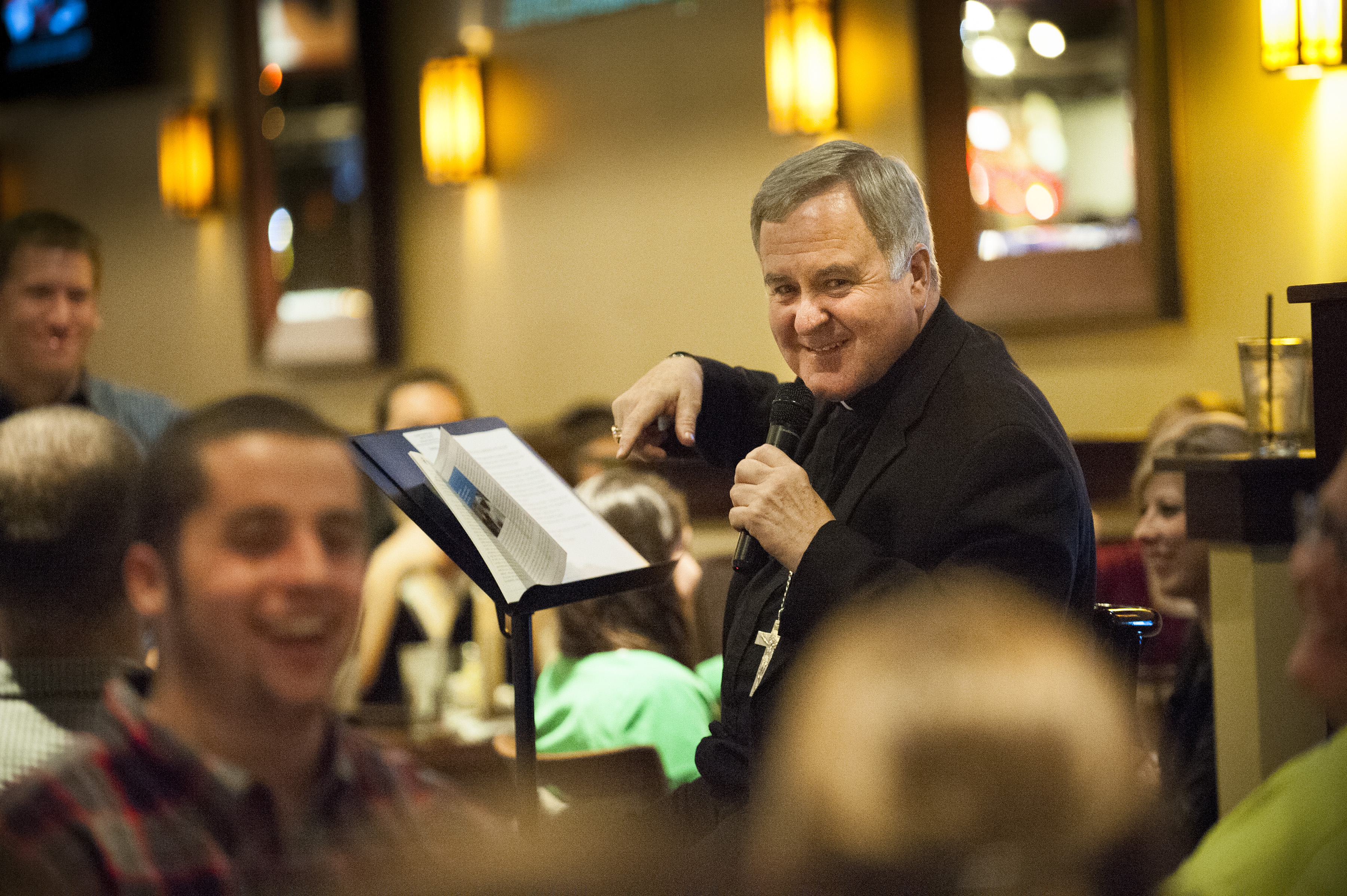
Archbishop Carlson has spent a busy and fruitful nine years as Shepherd of the Archdiocese of St. Louis. In addition to his many initiatives, he received the Interfaith Partnership Award in September, 2011. He was also honored with receiving the Joseph Cardinal Ritter Award in February, 2012, the Sister Mary Ann Eckhoff Leadership Award in April, 2012, the Service to the Community Award from the Ecumenical Leadership Council in May, 2012, the Order of Saint Louis King Award in November, 2015 and the Luminary Award for Criminal Justice in June, 2017.
Archbishop Carlson turned 75 on June 30, 2019, and as required by Canon Law, submitted his letter of resignation/retirement to the Pope. He continued to shepherd the faithful of the “Rome of the West" until the installation of his successor on August 25, 2020.
Archbishop Rozanski
The Most Reverend Mitchell Thomas Rozanski was born in Baltimore, Maryland on August 6, 1958. A Baltimore native of Polish-American descent, he lived with his family in Fells Point, MD where they attended Holy Rosary Parish.
He was ordained a priest of the Archdiocese of Baltimore at the Cathedral of Mary Our Queen on November 24, 1984. He served as an associate pastor at St. Michael, Overlea in 1984 and then the Cathedral of Mary Our Queen. He was appointed associate pastor at St. Anthony of Padua, Baltimore in 1985 and St. Isaac Jogues, Baltimore in 1990. He was appointed administrator of Holy Cross and St. Mary Star of the Sea parishes in Baltimore in March 1993, before being appointed pastor there in October. In January 2000 he was appointed temporary administrator of Immaculate Conception, Towson and in June assumed the same duties at St. John before being named its pastor on November 28,
Bishop Rozanski has served as bishop for the Diocese of Springfield, a position he was appointed to on June 19, 2014 by Pope Francis. He was installed on August 12, 2014, by Cardinal Sean O’Malley, OFM Cap.
On June 10, 2020 Pope Francis named him as the 10th archbishop for the Archdiocese of St. Louis, Missouri with his installation Mass for August 25, 2020.